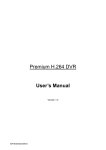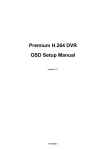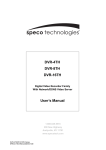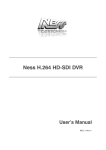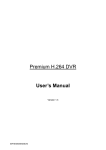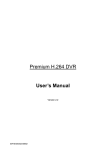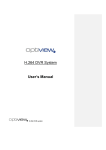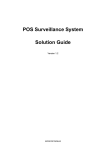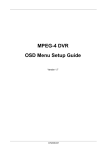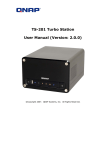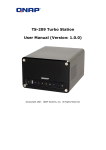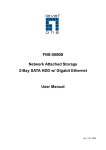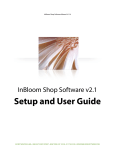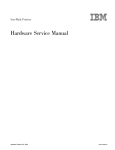Download Ness Ultimate Premium H.264 DVR User`s Manual
Transcript
Ness Ultimate Premium H.264 DVR User’s Manual REV1.2 Sep11 DVR User’s Manual Caution and Preventive Tips • Switch the 115/230V selector to your local voltage standard • Handle with care, do not drop the unit • Mount the unit in an equipment rack or place it on a solid, stable surface. • Indoor use only. Do not place the unit in a humid, dusty, oily, or smoky site. • Do not place it in an area with poor ventilation or in an area close to fire or other sources of heat. Doing so may damage the unit as well as cause fire or an electric shock. • When cleaning is necessary, shut down the system and unplug the unit from the outlet before uncovering the top cover. Do not use liquid cleaners or aerosol cleaners. Use only a damp cloth for cleaning. • Always shut down the system prior connecting or disconnecting accessories, with the exception of USB devices. This symbol intends to alert the user to the presence of important operating and maintenance (servicing) instructions in the literature accompanying the appliance. This symbol intends to alert the user to the presence of unprotected “Dangerous Voltage” within the product’s enclosure that may be strong enough to cause a risk of electric shock. 2 DVR User’s Manual Important Information Before proceeding, please read and observe all instructions and warnings in this manual. Retain this manual with the original bill of sale for future reference and, if necessary, warranty service. When unpacking your unit, check for missing or damaged items. If any item is missing, or if damage is evident, DO NOT INSTALL OR OPERATE THIS PRODUCT. Contact your dealer for assistance. Rack Mounting Consult with the supplier or manufacturer of your equipment rack for the proper hardware and procedure of mounting this product in a safe fashion. Avoid uneven loading or mechanical instability when rack-mounting units. Make sure that units are installed to get enough airflow for safe operation. The maximum temperature for rack-mounted units is 40 °C. Check product label for power supply requirements to assure that no overloading of supply circuits or over current protection occurs. Mains grounding must be reliable and uncompromised by any connections. 3 DVR User’s Manual Table of Contents 1. Overview .......................................................................................................................7 2. System Setup................................................................................................................8 2.1 Position the Unit .....................................................................................................8 2.2 Select Video Format ...............................................................................................8 2.3 Connect Devices to the Unit ...................................................................................8 2.4 Rear Panel Connectors ..........................................................................................9 3. General System Setup ...............................................................................................11 3.1 Front Panel Introduction ....................................................................................... 11 3.1.1 LED Definition............................................................................................ 11 3.1.2 Functional Keys .........................................................................................12 3.2 Enter OSD Setup Menu........................................................................................15 3.2.1 User Management .....................................................................................16 3.3 Power On / Shutdown the Unit .............................................................................17 3.4 System Date / Time Setting ..................................................................................18 3.4.1 Set Date / Time ..........................................................................................18 3.4.2 Daylight Saving Time .................................................................................19 3.4.3 Network Time Protocol Setup ....................................................................20 3.6 Record Schedule / Quality Setting........................................................................24 3.6.1 Schedule Setup .........................................................................................24 3.6.2 Preset Record Configuration .....................................................................25 3.6.3 Per Camera Configuration .........................................................................25 3.6.4 Record Event Video Only ..........................................................................26 3.6.5 ezRecord Setup .........................................................................................26 3.6.6 Data Lifetime..............................................................................................27 3.6.7 Pre-Alarm Recording .................................................................................27 3.6.8 Circular Recording .....................................................................................28 3.6.9 Audio Recording ........................................................................................28 3.6.10 Purge Data.................................................................................................28 3.7 POS and Text Setup .............................................................................................29 3.7.1 Text Function .............................................................................................29 3.7.2 Text Overlay...............................................................................................29 4 DVR User’s Manual 3.7.3 Exception Text Setup .................................................................................30 3.7.4 Input Setup ................................................................................................31 4. Basic Operation ..........................................................................................................33 4.1 View Live / Playback Video ..................................................................................33 4.1.1 Viewing Modes ..........................................................................................33 4.1.2 Digital Zoom...............................................................................................34 4.1.3 View Live Cameras....................................................................................34 4.1.4 View Recorded Video ................................................................................34 4.2 Sequence Setup...................................................................................................36 4.2.1 Sequence with Main Monitor (1st and 2nd) ...............................................36 4.2.2 Sequence with Call Monitor .......................................................................36 4.3 Search Recorded Video .......................................................................................37 4.3.1 Search by Time..........................................................................................37 4.3.2 Search by Event ........................................................................................38 4.3.3 Search by Text ...........................................................................................39 4.4 Video Export.........................................................................................................40 4.4.1 Export from OSD Setup Menu ...................................................................40 4.4.1.1 Select the External Device ...........................................................40 4.4.1.2 Select Video for Exporting ............................................................41 4.4.1.3 Digital Signature ...........................................................................42 4.4.1.4 Erase Disc ....................................................................................42 4.4.2 Quick Video Export through Front Panel ...................................................42 4.4.2.1 ezBurn Introduction ......................................................................42 4.4.2.2 Export Normal Video ....................................................................43 4.4.2.3 Export Event Video.......................................................................44 4.5 Dome Control .......................................................................................................44 4.5.1 Dome Connection ......................................................................................44 4.5.2 Dome Protocol Setup.................................................................................45 4.5.3 RS485 Setup .............................................................................................45 4.5.4 Dome Controlling Key................................................................................46 4.5.5 Set Preset Points .......................................................................................47 4.5.6 Call Preset Points ......................................................................................48 4.6 Intercom Function.................................................................................................49 4.7 UPnP Function .....................................................................................................49 4.7.1 Setting Up the DVR and the PC.................................................................50 4.7.2 UPnP NAT Traversal Function ...................................................................50 5. Remote Monitoring Software.....................................................................................51 5.1 Remote Monitoring System Requirements ...........................................................51 5.2 Software Installation .............................................................................................52 5.2.1 Change Internet Settings ...........................................................................52 5 DVR User’s Manual 5.2.2 Install Remote Monitoring Software ...........................................................54 5.2.2.1 Log in / Log off..............................................................................55 5.2.2.2 Software Upgrades.......................................................................56 5.3 Basic Operation for Monitoring Remotely .............................................................56 5.3.1 View Live Video .........................................................................................56 5.3.1.1 Select Display Mode.....................................................................57 5.3.1.2 Operate Cameras with Dome Control ..........................................57 5.3.2 Instant Recording.......................................................................................58 5.3.2.1 Record Video Instantly .................................................................58 5.3.2.2 Playback Instant Recorded Video ................................................58 5.3.3 Playback Video ..........................................................................................59 5.3.3.1 Playback Remote Video ...............................................................59 5.3.3.2 Playback Local *.drv Files ............................................................60 5.3.3.3 Playback Controls ........................................................................60 5.3.4 Verify Digital Signature ..............................................................................61 5.3.5 Search from Event List ..............................................................................61 5.3.6 Take a Snapshot ........................................................................................61 5.3.7 Remote Monitoring Software Trouble Shooting Guide...............................62 Appendix A: Recommended HDDs ................................................................................63 Appendix B: Remote Controller .....................................................................................64 Appendix C: USB Mouse Operation ...............................................................................66 Appendix D: Keyboard Access Sketch ..........................................................................67 Appendix E: Simultaneous Output Options ..................................................................68 Appendix F: Jog / Shuttle Control ..................................................................................69 6 DVR User’s Manual 1. Overview The Premium H.264 DVR is an integrated digital video recorder that combines the features of a time-lapse audio / video recorder, a multiplexer, and a video server to create a single security solution. Its outstanding pentaplex operation enables users to view live video, search and playback any recorded video by date/time or event, remotely monitor the unit via internet on PCs or mobile devices, and backup the configuration and video data, MEANWHILE recording simultaneously. The Premium H.264 DVR is pre-installed with remote viewing and configuration software, which is a Web-browser plug-in allowing users to view live or recorded video images, and enables remote configuration. The remote software is stored in the Premium H.264 DVR and deployed over a LAN, WAN or Internet connection to remote Windows-based computers. This simplifies the installation and maintenance of the software components so all remote users are using the same software coming from the unit. 7 DVR User’s Manual 2. System Setup The notices and introduction on system installation will be described particularly in this chapter. Please follow the description to operate the unit. In order to prevent the unit from data loss and system damage that caused by a sudden power fluctuation, use of an Uninterruptible Power Supply (UPS) is highly recommended. 2.1 Position the Unit Firstly, note to position / mount the DVR in a proper place and be sure to power off the unit before making any connections. The placed location should avoid hindering or blocking the unit from airflow. Enough airflow is needed to protect the unit from overheating. The maximum allowable temperature of operating environment is 40°C. The unit utilizes heat-conducting techniques to transfer internal heat to the case, especially to the bottom side of the unit. NOTE: Be sure the rubber feet are not removed, and always leave a space for air ventilation on the unit’s bottom side. 2.2 Select Video Format The DVR is designed to operate under either NTSC or PAL video formats. The switch is positioned on the rear panel. 2.3 Connect Devices to the Unit This section lists some notices that should be given before making any connections to the DVR. Connecting Required Devices Before powering on the unit, cameras and a main monitor should be connected to the unit for basic operation. If needed, connect a call monitor for displaying full screen video of all installed cameras in sequence. 8 DVR User’s Manual Connecting Short-term Device If any short-term devices shall be installed to the DVR as parts of the unit system, such as USB ThumbDrive® or any USB devices, etc., make sure those devices are connected only after the unit is powered on. The reason is because the DVR can recognize the external devices only after the power-on process is done completely. 2.4 Rear Panel Connectors There are various connectors on the rear panel for the DVR installations. The connectors are described as the followings. Main Monitor (S-Video / BNC) Both S-Video and BNC output connectors are offered for connection to a main monitor. The main monitor displays live image and playback recorded video in full-screen or split-window format. Call Monitor (BNC) The call monitor is used to display full screen video of all installed cameras in sequence. The BNC call monitor connector allows user to connect the DVR with a call monitor. VGA Output VGA output connectors are offered for connecting to VGA main monitors. Some models provide one while other models provide two VGA connectors. Dual VGA VGA + Digital Output Digital Output A digital output connector is provided for connection to a displaying device that transfers data digitally to show the best video quality. NOTE: Refer to Appendix E: Simultaneous Output Options for detailed information about monitor functionality. Video Input A group of BNC connectors is offered for video input streams from installed cameras. The number of connectors is equal to the number of channels. Video Out Plenty of BNC connectors are positioned on the rear panel for looping out the video input. RS-232C The unit provides a RS-232C communication port for sending and receiving signals. 9 DVR User’s Manual Alarm I/O & RS485 The unit provides alarm I/O and RS-485 ports that offer users the flexibility required to connect the unit to the other device. The definition for pins varies when the DVRs have different channels. Refer to Setup Guide for detailed pin definitions. NAS The NAS connector allows users to connect a Network Attached Storage (NAS) device to expend HDD capacity of the DVR. LAN 10/100/1000M (RJ-45) The DVR is capable of networking and it allows the videos to be viewed over the LAN network or the Internet by using the Internet Explorer. USB Connector (x2) There are two USB2.0 ports on the rear panel for users to connect external USB devices to the unit, such as ThumbDrive®, DVD+RW, or a USB mouse. Audio Out (Optional) The DVR provides two types of connectors for connection to audio output devices, such as amplified speakers. One is a RCA connector to output audio associated with the main monitor. The other is an optional terminal block providing connections with all channels for the purpose of two-way audio talk function. Refer to Setup Guide for detailed pin definitions. Audio In A terminal block titled “AUDIO IN” provides connections to audio source devices of all channels for the purposes of audio recording and two-way audio talk function as well. Refer to Setup Guide for detailed pin definitions. Power Switch Use this switch to power on or shutdown the DVR. Power Jack Connect the power supply cord shipped with the DVR. NOTE: Use of other power supply cords may cause overloading. 10 DVR User’s Manual 3. General System Setup Before operating the DVR, some general configuration should be setup first. The following subsections will introduce function keys on the front panel and general configuration of the DVR. The regular displayed OSD information and its displayed positions are shown as following figure. Title of the channel will be displayed on the top-left corner of the window, either in full screen mode or in multiple channel mode. The current operating mode, including Call mode, Dome Control mode, Playback mode, Freeze mode and Sequence mode, will be displayed on the bottom-left corner of the screen. The date/ time information will be display on the bottom-right corner of the screen. Ch4 2008/11/09 ►*1 3.1 PM04:31:22 Front Panel Introduction The front panel controls enable users to control the unit and preset the programmable functions. 3.1.1 LED Definition The LEDs on the front panel of the DVR are described as follows. Power LED The LED lights up when the correct power is connected to the unit. Network LED The LED lights up when the DVR is connected to a network and blinks when data is being transferred. REC LED The LED blinks while the DVR is recording. 11 DVR User’s Manual Alarm LED The LED lights up when an alarm is triggered. HDD LED The LED lights up while the HDD is processing data to or from the connected HDD. 3.1.2 Functional Keys This section describes the functional keys, which are for normal operation, on the front panel of the DVR. Please refer to the Setup Guide for the graphical illustration of functional keys. CHANNEL • In both Live and Playback modes, press the CHANNEL key to view the corresponding video in full screen. The number of the CHANNEL keys corresponds to the number of cameras supported by the unit. • In Dome Control mode, the key “1” is used to access the Set/Go preset menu; the key “2” is used to hide or display the dome camera setting parameters. COPY In Playback mode, press COPY to select the start and end time of the export video. Refer to section Video Export for detailed information. CALL • In Live mode, press this key once to control the call monitor. Alternatively, press and hold this key for 3 seconds to control the 2nd main monitor. • In Dome Control mode, press CALL in association with ENTER to enter the OSD setup menu of the dome camera. DOME Press the key to enter Dome Control mode. Please refer to Section Dome Control for detailed controlling operation. 12 DVR User’s Manual MODE Press repeatedly to select desired main monitor display format. There are four available view modes: full screen, 4-window (2×2), 9-windows (3x3) and 16-window (4×4). Refer to section Viewing Modes for detailed information. PLAY Press this key to switch between live image and playback video. NOTE: The video of latest 5 ~ 10 minutes cannot be played back because the video is still saved in the buffer. FREEZE • Press FREEZE while viewing live image, the live video will be frozen. The date / time information shown on the monitor will continue updating, as well as the recording of video. Press FREEZE again to return to live mode. • Press FREEZE while playing the recorded video, the playback video will be paused. Press LEFT / RIGHT to move the recorded video reverse / forward by single step. Press FREEZE again to continue playing video. SEQ (Sequence) Press to start automatic sequence display of video from all installed cameras. MENU Press this key to enter the OSD setup menu. SEARCH In both Playback and Live mode, press SEARCH to enter the Search menu for searching and playing back recorded video by date / time, event, or text. Direction Keys • In Zoom mode, these keys function as Direction keys. • In the OSD setup menu, the LEFT / RIGHT keys are used to move the cursor to previous or next fields. To change the value in the selected field, press UP / DOWN keys. 13 DVR User’s Manual ENTER / ZOOM • In OSD setup menu or selection interface, press this key to make the selection or save settings. • In live full screen viewing mode, press this key to view a 2× zoom image; press it again to return. ESC • Press to cancel or exit from certain mode or OSD setup menu without changing the settings made previously. • If the password protection has been enabled, press ESC for five seconds to lock up the function of certain keys, including PLAY, MENU, SEARCH, and DOME. Once users lock up the function of these keys, correct password must be entered before accessing the functions of these keys. NOTE: Please go to the <Password> menu to enable or disable the password protection. JOG/ SHUTTLE (for specified models) The jog/shuttle knob, shown as the figure on the right, is a combination of a shuttle ring with an embedded jog disk. It provides wide latitude in playback control. Note that the jog/shuttle knob is active only when the DVR is in Playback mode. Please refer to Appendix F: Jog / Shuttle Control for further information. 14 DVR User’s Manual 3.2 Enter OSD Setup Menu The configuration of the DVR can be customized by entering the intuitive Graphical User Interface (GUI) OSD setup menu. Collaborating with a USB mouse, setting up the DVR can be easy as operating on a PC. Press MENU and input a valid username. A preset username “admin” can be inputted via pressing the hot key MENU. Move to <OK> and press ENTER to proceed. Input Username A N a n 0 # B O b o 1 − C D E P Q R c d e p q r 2 3 4 _ , “ ◄ ► Cancel F G H I S T U V f g h i s t u v 5 6 7 8 + = * Backspace OK J W j w 9 K X k x . L Y l y ! M Z m z @ Delete The next step is to enter a corresponding password. The preset password for “admin” is “1234”. Password Verification _______ Press Channel Keys To Enter Password (4-8 Digits) Press ◄ Key To Delete NOTE: It is strongly suggested to change the preset password to prevent unauthorized access to the unit. An icon displayed at the center-bottom of the screen will show the authority level of the account. Under logout condition, the icon will show “N”. When an account is logged in, its authority level number (1~8) will be shown. Before completely logout, other functions can also be accessed without having to login again. There is two way to logout: manually logout by pressing ESC key at Live mode, or auto logout when keys are not pressed for 5 minutes at Live/ Menu mode. 15 DVR User’s Manual 3.2.1 User Management The DVR provides the option to create up to seven sets of usernames and passwords with customized authority, excluding the preset “admin” account. From the Main Menu, select <System Setup> Æ <User Management> and the menu is as the following: User Management 1. Password Protection 2. Account Setup 3. Authority Setup 4. Load Default Setting ON No Password Protection Select <ON> to request for username and password for accessing functions listed in Authority Setup menu, or select <OFF> to allow free access. Account Setup Setup customized username, password, and authority level in this menu. The username is case sensitive. The authority level rank from level 1~8, and level 8 has highest authority. Alternatively, select <Disable> to stop using the account. NOTE: The username and authority level of the preset “admin” account cannot be changed. Authority Setup Setup the allowed authority level for accessing the functions listed in this menu. The functions include: Playback/Search, Dome Control, Call Control, Export Data, Menu Access, System Setup, Monitor Setup, Camera Setup, Record Setup, Sequence Setup, Event Setup, Database Setup, Configuration, Text Setup, and Shutdown. The authority level rank from level 1~8, and level 8 has highest authority. Alternatively, select <Disable> to allow free access. NOTE: The “Menu Access” cannot be set to <Disable>. When the account does not have authority to access certain functions, an error message will be displayed on the screen. Load Default Setting Select <Yes> to load the default setting. 16 DVR User’s Manual 3.3 Power On / Shutdown the Unit If the DVR must be shutdown for any reason, please use the proper shutdown and power on procedures to avoid damaging the DVR. To Power On the Unit: Check the type of power source before plug in the power cord to the DVR (the acceptable power input is between AC110V ~ AC240V), and power on the unit using the power switch on the rear panel. The color bar and system checking information will be shown on the monitor and then disappear when the unit has been completely powered up. To Restart / Shutdown the Unit: Press MENU and input the username and password that has sufficient authority to access the OSD setup menu. Select <Shutdown> in Main Menu and press ENTER to enter the Shutdown menu, which displays as follows. Shutdown 1. Power Off 2. Reboot Execute Execute Power Off Select this item to shut down the unit. Do not remove the power during shut down until the message “You can safely turn off DVR now!” displays. Reboot Select this item to reboot the unit. The color bar and system checking information are displayed on the monitor until the unit is completely restarted. 17 DVR User’s Manual 3.4 System Date / Time Setting Users can set the current date, time and other OSD parameters in Date/Time menu (under System Setup menu). The login account should have authority to access the System Setup menu. In OSD setup menu, select <System Setup> and press ENTER, then select <Date/Time> to access the Date/Time menu; the menu displays as follows. Date/Time 1. Date 2. Time 3. Time Zone 4. Date/Time Display 5. Date Display Mode 6. Time Display Mode 7. Date/Time Order 8. Daylight Saving Time Setup 9. Network Time Protocol Setup 3.4.1 2008/02/21 PM10:39:26 OFF 1 Row Y/M/D 24 HR Date First Set Date / Time Set Date / Time Select <Date>, or <Time> and press ENTER for adjusting the settings. LEFT / RIGHT keys are used to move the cursor to previous or next field, ENTER is for selecting, and UP / DOWN are used to change the value in the selected field. NOTE: The new date / time setting applies to record new video. The date and time of previously recorded video will not be changed. NOTE: If time settings have to be changed in any case, it is strongly recommended to format the HDDs to avoid database corruption. Date / Time Display Users are allowed to set the time OSD displays in 1 or 2 rows. Use the UP / DOWN keys to change the setting. 18 DVR User’s Manual Date Display Mode This function allows user to set the OSD display type of the date. There are three options to select from: <Y/M/D>, <M/D/Y> or <D/M/Y>. “Y” represents “Year”, “M” represents “Month” and “D” represents “Day”. Move to the item and press ENTER, the option starts blinking. Use UP / DOWN keys to change the setting. Time Display Mode User can set the time format to <12 hour> or <24 hour>. Use the UP / DOWN keys to change the format. Date / Time Order The item is used to set the order of date / time display to <Date First> or <Time First>. Use UP / DOWN keys to change the setting. 3.4.2 Daylight Saving Time Daylight Saving Time The item is for people who live in certain regions to observe Daylight Saving Time. Select <ON> to enable, or <OFF> to disable the function. If the function is disabled, the DST Start / End time and DST Bias will be grayed out and cannot be accessed. NOTE: If this function is enabled, the date/time information will be shown on the screen with a DST icon when playing back recorded video or searching video in the event list. “S” indicates summer time and “W” indicates wintertime. DST Start / End The items are used to program the daylight saving duration. Use LEFT / RIGHT keys to move the cursor to the next or previous field, UP / DOWN to change the settings in the selected field. DST Bias The item allows user to set the amount of time to move forward from the standard time for daylight saving time. The available options are in minutes. 19 DVR User’s Manual 3.4.3 Network Time Protocol Setup Time Zone Select <Time Zone> to enter the time zone. To find out the correct local time zone, please visit www.greenwichmeantime.com or refer to the following figure. NOTE: The <Time Zone> must be set to the correct local time zone or the <Network Time Protocol Setup> will not be accessible. Network Time Protocol Setup After entering the time zone, the <Network Time Protocol Setup> option will appear. Select the <Network Time Protocol Setup> to set the time server. The default time server is time.nist.gov, but the user can change it to other time servers when desired. A list of IP addresses of the time servers is listed below. 129.6.15.28 132.163.4.102 192.43.244.18 206.246.118.250 207.200.81.113 129.6.15.29 132.163.4.103 131.107.1.10 208.184.49.9 64.236.96.53 132.163.4.101 128.138.140.44 69.25.96.13 64.125.78.85 68.216.79.113 After the time server is set, select <Manually Time Sync> to sync the time. The time sync can also be updated periodically. Select <Automatically Time Sync>, and the time will be automatically synced once an hour. 20 DVR User’s Manual This page is intentionally blank 21 DVR User’s Manual This page is intentionally blank 22 DVR User’s Manual This page is intentionally blank 23 DVR User’s Manual 3.6 Record Schedule / Quality Setting The Record Setup menu allows users to set recording quality, recording schedules, and other recording parameters. Login with a proper account to access Record Setup menu. In the Main menu, move the cursor to <Record Setup> and press ENTER; the following menu is displayed. Record Setup 1. Record Mode Setup 2. Schedule Setup 3. Preset Config 4. Per Camera Config 5. ezRecord Setup 6. Data Lifetime 7. Pre-Alarm Recording 8. Circular Recording 9. Audio Recording 10. Purge Data 3.6.1 Best Quality 0 Days 15 Sec ON ON Schedule Setup The Schedule Setup is used to set the day and night time, or weekend recording schedule. Select <Schedule Setup> from the Record Setup menu and press ENTER; the following menu is displayed. Schedule Setup 1. Day Time Start 2. Day Time End 3. Night Time Start 4. Night Time End 5. Weekend Schedule 6. Weekend Start 7. Weekend End AM06:00 PM06:00 PM18:00 AM06:00 ON Fri AM18:00 Mon PM06:00 • Make appropriate changes of the start time of Day and Night Time using Direction keys. • Press ENTER to confirm the settings or ESC to cancel. • If a weekend record is required, select <ON> to enable the Weekend Schedule in advance and then set the Weekend Start/End time. • Press ESC to return to previous page. 24 DVR User’s Manual 3.6.2 Preset Record Configuration The <Preset Config> is used to select the preset recording quality and frame rate. In normal circumstances, it is strongly recommended to set the preset configuration as <Best Quality>. Below table shows the PPS and picture size under <Best Quality> in Half-D1 mode. Please refer to OSD Setup Manual, Section Preset Record Configuration for further information. Half-D1 mode (NTSC: 720x240@120PPS; PAL: 720x288@100PPS) Normal PPS Normal Size Event PPS Event Size 7.5 NTSC (6.25 PAL) 3.6.3 12 KB / Pic 30 NTSC (25 PAL) 12 KB / Pic Per Camera Configuration This function is used to set the Day / Night / Weekend PPS (Picture per Second) and Quality for each channel. The Preset Configuration must be set to <OFF> for accessing these schedules. The menu is displayed as below (Record Mode: 720×240@120PPS in NTSC / 720×288@100PPS in PAL). Per Camera Config Cameral Select Normal PPS Normal Qlty Event Max PPS Event Qlty Event Act Day 7.5 Mid 30 Best Both Night 7.5 Mid 30 Best Both CH1 Weekend 7.5 Mid 30 Best Both • First, select a Camera for setting its record configuration. The image and recording settings from the selected camera will be displayed on the screen. • • • • Move the cursor using Direction keys and press ENTER to select an item. Change the value using UP / DOWN keys. Press ENTER to confirm the settings or ESC to abort. Press ESC to return to Record Setup menu. Please note that the total normal PPS for all channels cannot exceed 120 NTSC (720×240@120PPS) / 100 PAL (720×288@100PPS). To increase one channel’s PPS, others’ may have to be reduced first. Event PPS is not restricted to this rule, since a smart event scheduler will handle the total PPS with a correct weighting. 25 DVR User’s Manual 3.6.4 Record Event Video Only If the DVR shall start recording only when alarms are triggered, follow the steps below: • Enter the OSD setup menu with correct password. • In the OSD setup menu, select <Record Setup> menu. Move the cursor to the item <Preset Config>, and select <Event only>. Refer to OSD Setup Manual, Section Preset Record Configuration for further information. 3.6.5 ezRecord Setup This item aims to ease the complicated record settings, and to make the setup much easier. Note that the item can be reached only when <ezRecord> is selected as the option for <Preset Config>. Select <ezRecord Setup> from <Record Setup> and press ENTER, the sub-menu appears as below figure: ezRecord Setup How Many Days To Record Daytime Record Night Record Weekend Record Record Info Average Normal PPS Average Normal Quality 2 Days Yes Yes Yes 15 Best Follow these steps to Setup ezRecord: 26 • Select <How Many Days To Record> and press ENTER, then press UP/DOWN to choose an option. The average normal PPS & Quality will be adjusted automatically. The maximum of days depends of the size of the installed HDD(s). In other words, the larger the size of the HDD installed, the more days the unit can record. • Move to <Daytime Record> and press ENTER. This item will determine whether the DVR will record during daytime. If yes, use UP/DOWN to select <Yes> as to enable daytime recording; or select <No> to disable. • Repeat the same procedures through the 3rd and 4th item, respectively. Note that <Weekend Record> will be inaccessible if <Weekend Schedule> in <Schedule Setup> is set to <No>. DVR User’s Manual • Select <Average Normal PPS> and press ENTER, then press UP/DOWN to make a choice. The <How Many Days To Record> will be computed automatically. • Select <Average Normal Quality> and press ENTER, then press UP/DOWN to make a choice. The <How Many Days To Record> will be computed automatically. NOTE: The current number of connected cameras will affect the recording quality automatically calculated through the <ezRecord Setup>. Therefore, once the number of connected cameras is changed, the <ezRecord Setup> should be reset. 3.6.6 Data Lifetime Data Lifetime indicates the duration that a video is saved and recallable in the HDD. Only those video recorded within Data Lifetime can be displayed on the screen and played back. The video exceeded Data Lifetime will be hidden and cannot be retrieved for playback. Press ENTER to select this item in Record Setup menu, and then use UP / DOWN keys to set the data lifetime. The value ranges from <1> to <365> days, or select <0> to disable the function. NOTE: To play back a video exceeding the data lifetime, please extend the duration until the recording data / time of the video is included. 3.6.7 Pre-Alarm Recording This item is used to set the recording duration of pre-alarm video. The pre-alarm recording function aims to allow the user to view a complete event video. What user can view is not only the video recorded after the alarm is triggered, but also the video recorded few seconds before the alarm is triggered. When an event is triggered while normal recording is in effect, the unit will start copying the pre-alarm and the post-alarm video to the event video. The pre-alarm duration can be set from 0~30 seconds. The quality of the pre-alarm video is the same as the quality setting for normal record video; and the quality of the post-alarm video is the same as the quality setting for event record video. 27 DVR User’s Manual 3.6.8 Circular Recording Users can choose to record video in circular mode or in linear mode. If circular mode is selected, the DVR will stores new video into the HDD spaces while overwrite the oldest recorded video. Alternatively, if linear mode is selected, the DVR will stop recording when the HDD is full. In the meantime, the internal buzzer will start beeping and a message will be shown on the screen informing users that the disk is full. From the Record Setup menu, move the cursor to <Circular Recording> and press ENTER, then select <ON> / <OFF> using UP / DOWN keys. 3.6.9 Audio Recording This item allows user to enable / disable Audio recording function of the unit. When it’s set to <ON>, audio input is recorded and saved with the video. When it’s set to <OFF>, audio is ignored. 3.6.10 Purge Data This item is used to delete the Normal or Event recording video. In Record Setup menu, move the cursor to <Purge Data> and press ENTER; the Purge Data menu is displayed. Purge Data 1. Purge All Data 2. Purge All Event Data 3. Purge Event Before 4. Start to Purge No No 2008/01/01 No Purge All Data The item is used to delete all recorded video from the database. Set this item to <Yes using UP / DOWN keys, and start the deletion by setting <Start to Purge> to <Yes>. Purge All Event Data The item is used to delete all event video from database(s). Using UP / DOWN keys to select <Yes> and start the deletion by setting <Start to Purge> to <Yes>. 28 DVR User’s Manual Purge Event Before The item is used to delete event video before a specific date. Use LEFT / RIGHT keys to move the cursor to next or previous field, ENTER to select the item and UP / DOWN to adjust the value. Start to Purge After the video or data to be deleted are selected, set this item to <Yes> to start the deletion or choose <No> to cancel. 3.7 POS and Text Setup The <Text Setup> function provides a connection between the DVR and a Point-of-Sale (POS) device, such as a cash register. With this function, the financial transaction data can be linked to specific camera images and recorded to the DVR. To enable this function, enter OSD Setup menu with proper account, and select <Text Setup>. Press Enter and the following OSD setup menu will show up. Text Setup 1. Text Function 2. Text Overlay 3. Exception Text Setup 4. Input Setup 3.7.1 ON Live & PB Text Function This item is used to enable/ disable this function. Select <ON>, the text database will be created on the hard disk. 3.7.2 Text Overlay Users can decide when the text overlay should be displayed on the monitor. Select <Only Live> to display the text overlay in Live mode; select <Only PB> to display the text overlay in Playback mode; or select <Live & PB> to display in both modes. NOTE: Text overlay will only be displayed in full screen mode. NOTE: PB overlay is available only under x1 PB speed. 29 DVR User’s Manual 3.7.3 Exception Text Setup This sub-menu is used to define the conditions that are to be treated as an “Exception” and thus trigger an action (the function will be implemented later). Exception Text Setup Exception No. Trigger Exception String By Numerals Value Value (Upper Limit) 1 ON NO SALE OFF Exception No. Select a number to set the exception parameters. The total is 16 exceptions. Trigger Select <ON> to monitor if transactions satisfy exception parameters. Once an exceptions is found, alarm will be triggered. Exception String Users can define Exception String. The “Exception String” is case-sensitive. Only exactly matched ones will be marked as exceptions. By Numerals “Exception String” must be defined before “By Numerals” takes effect. If “By Numerals” is enabled, only transactions which meet both “Exception String” and “By Numerals” creteria will be marked as exceptions. The selections are as the following: <OFF>: The function is disabled. <Specific>: When the value of a transaction meets a specific value, it will be marked as an exception. That specific value need to be defined in the following sub-setting <Value>. <Greater Equal Than>: When the value of a transaction is greater then or equal to a certain value, it will be marked as an exception. That specific value need to be defined in the following sub-setting <Value>. <Less Equal Than>: When the value of a transaction is less than or equal to a certain value, it will be marked as an exception. That specific value need to be defined in the following sub-setting <Value>. 30 DVR User’s Manual <Inside The Range>: When the value of a transaction is within a certain range, it will be marked as an exception. The range need to be defined in the following sub-setting <Value> and <Value (Upper Limit)>. <Outside the Range>: When the value of a transaction is beyond a certain range, it will be marked as an exception. The range need to be defined in the following sub-setting <Value> and <Value (Upper Limit)>. NOTE: Transactions will be marked as exceptions in text database only when: (1) “Exception Strings” and “By Numerals” are set and (2) “Trigger” is <ON>. The data stored before hand will not be marked as exceptions. 3.7.4 Input Setup This item is used to configure the connection settings of the POS device. Input Setup 1. Port Selection 2. Input Source 3. Camera Selection 4. Text Filter 5. Manual Filter Setup 6. Input Process 7. Text Baud Rate 8. Text Bits 9. Text Stop 10. Text Parity Serial Port Direct Connected 1 ASCII Canonical 9600 8 1 None Port Selection It is essential to select a correct port for the POS device. Meanwhile, make sure the POS device is connected to the port selected. Input Source Select the input source of the POS device, either direct connected or connected with the Data Converter. Camera Selection Select a camera to display the text overlay. 31 DVR User’s Manual Text Filter This item is used to choose the text filter. The supported models for pole display and printer are listed as below. Pole Display Cache Technology VFD-202T Citizen C2202 Digipos CD5220 Emax Pole Display Epson DM-D Series Logic Controls LD9000 Logic Controls PD3000 Logic Controls PD6000 Logic Controls TD3000 Magellan Partnertech CD5220 Posiflex ICD-2002 Posiflex PD 302 Posiflex PD 303 Posiflex PD-2100 Posiflex PD-2200 POS-X Xp8000 Scales Sibnet STAR SCD400-PD Soteke VFD2025 Soteke VFD2029 TEC Toledo 8217 TYSSO VFD Series Ultimate Technology PD1100XL Wedderburn DS-770 Printer Citizen CBM-1000 II Citizen CT-S300 Dell T200 Epson TM-T88II/TM-T88III/TM-T88IV Epson TM-T90 Epson TM-930 II Epson RP-U420 IBM SureMark TF6 IBM SureMark TM6 Ithaca iTherm 280 Ithaca POSJet 1000 POS-X Xr500 Samsung SRP350 Sensor TP-288 Star TSP100 futurePRNT Star TSP600 Star TSP700 Star TSP800 TPG (Axiohm) A794 WP-520(ESC/POS) POS Machine Acula AQ-812 IBM SurePOS 700 Samsung ER-380M Samsung ER-655 Senor POS Manual Filter Setup Once enter the Manual Filter Setup menu, users should key in hexadecimal digits. The menu of the item is shown as follows. Manual Filter Setup 1. Header 1 2. Header 2 30 30 Input Process If a pole display from a PC based POS device will be used, select <Canonical>. <Non-Canonical> is to be selected when using a Pole Display from a Standalone POS device. Text Baud Rate, Bit, Stop, Parity To setup the baud rate, bit, stop, and parity of RS232 which connects the POS device and DVR. 32 DVR User’s Manual 4. Basic Operation The DVR allows user to access some general operations through the front panel easily. The following sections introduce the general operations of the unit. 4.1 View Live / Playback Video The general functions in live and playback mode are described in the following sections. 4.1.1 Viewing Modes The DVR provides versatile ways of viewing both live and recorded video. Following presents these view formats. Viewing in Full Screen Press any CHANNEL key directly to view the corresponding camera image in full screen format. Viewing in Multi-window Various multi-window view formats are offered for selection. To switch between available viewing formats, press MODE repeatedly. The available view formats are illustrated as the following figure. NOTE: 3x3 viewing mode is only available in 8-ch and 16-ch models, whereas 4x4 viewing mode is only available in 16-ch models. 33 DVR User’s Manual 4.1.2 Digital Zoom Users are able to view a 2× full screen in live mode. To view the 2× full screen, follow the steps. • Press any CHANNEL key to view the corresponding camera in full screen. • Press ENTER to view 2× zoomed screen of the selected camera. • To view a specific area in 2× zoomed screen, use Direction keys to pan / tilt the zoomed screen. • Either press ENTER again or press ESC to leave the Zoom mode. 4.1.3 View Live Cameras Users are allowed to view live camera in versatile viewing modes, including full-screen, 2×2, 3×3 and 4×4. The general operation under live mode is described as follows. Freeze Live Image Press FREEZE while viewing live image, the image pauses but the date / time information does not, and the system clock continues running. Press FREEZE to pause the live image; press FREEZE again to resume the live camera view. 4.1.4 View Recorded Video To view recorded video, user can press PLAY key directly. After pressing the PLAY key, the unit starts to continue playing back the recorded video from the suspended point of record. If it is the first time to use the PLAY key, the unit will playback from the very beginning of the record. Alternatively, user can select records from the Search menu to play specific video. Refer to section Search Recorded Video for further information. The Forward or Reverse speed indicator will be shown on the bottom-left of the screen, when in the playback mode. The general operations in playback mode are described as follows. 34 DVR User’s Manual Key Usage in Playback The key usage is slightly different in playback mode. Following is the key usage found in playback mode. z LEFT (Reverse Playback) The key is used to reverse the recorded video while the unit is playing back. Press the key repeatedly to increase the speed of reverse playback by 1×, 2×, 4×, 8×, 16×, or 32×. z RIGHT (Forward Playback) The key is used to play the recorded video fast forward. Press the key repeatedly to increase the speed of forward playback by 1×, 2×, 4×, 8×, 16×, or 32×. z FREEZE Press FREEZE to pause the playback video. When the recorded video is paused, press LEFT / RIGHT to resume playback video single step reverse / forward, respectively. Press FREEZE again to continue playing video. z PLAY Press it to start playing back video, exit current mode, or stop playing back video and return to live mode. Pause Playback and Single Step Forward To pause and resume recorded video, follow these steps. • Press any CHANNEL key to view the corresponding camera in full screen. • Press FREEZE to pause the current playback image. • Press RIGHT / LEFT Direction keys to move the video single step reverse / forward. Press and hold RIGHT / LEFT keys to repeatedly reverse / forward the video single step. • Press FREEZE again to resume the playback operation. 35 DVR User’s Manual 4.2 Sequence Setup This section introduces the way to view sequence mode with both Main Monitor and Call Monitor, if connected. Sequence function can avoid manual backtracking and provides more flexibility while monitoring surveillance. 4.2.1 Sequence with Main Monitor (1st and 2nd) Automatic sequence function can be observed in any view mode. Select certain view format and press SEQ to toggle the automatic sequence; press ESC to stop sequencing. The figure below displays the 4-camera and 9-camera sequencing view modes. 4-camera: 9-camera: (for 16ch models only) 4.2.2 Sequence with Call Monitor Users are allowed to use the front panel of the DVR to control a call monitor display without having to access the Main menu. Two viewing modes can be displayed on call monitor: Sequence display and Single camera display. To program the call monitor sequence, see OSD Setup Manual, Section Sequence Setup. Follow the steps to control the call monitor. • Press the CALL key on the front panel to enter call monitor control mode. The message “Call Mode” will be shown on the bottom-left of the screen. Press 1-16 Key To Select Channel Press SEQ To Enable Sequence Call Mode • Press CHANNEL key to display the associated camera on call monitor. • Alternatively, press SEQ repeatedly to display the sequence of cameras previously programmed in Call Monitor Schedule menu. • Press ESC to return the front panel to Main monitor control mode. 36 DVR User’s Manual 4.3 Search Recorded Video The DVR is capable of searching and playing back recorded video by date / time, events, or text. In live or playback mode, press SEARCH to enter the Search menu, which is shown as follows. Search ----------------------------Search By Time---------------------------From: 2008/01/01 00:00:00 End: 2008/05/01 00:00:00 Select: 2008/01/01 00:00:00 Begin Playback ----------------------------Search By Event---------------------------Select Channel: CH1 CH2 CH3 CH4 Event List -----------------------------Search By Text----------------------------Text Query Page NOTE: “Search By Text” only functions when a POS machine is connected and text data is stored. 4.3.1 Search by Time Follow the steps to search video by date and time. • Press SEARCH key to enter the Search menu. • Move the cursor to “From Time” and press ENTER will start playing recorded video from the specified “From Time”. • Move the cursor to “End Time” and press ENTER will start playing recorded video from the specified “End Time”. • Use Direction keys to move the cursor for setting the start time. Adjust the date and time values by UP / DOWN keys. • Press ENTER to confirm the settings or ESC to abort. • Move the cursor to <Begin Playback> and press ENTER to start playing back the selected video. • Either press PLAY again or ESC to return to live video. NOTE: If there is no available recorded video that matches the specified time and date, the unit starts playback from the next available video. NOTE: The date/time information will be shown on the screen with a DST icon if the Daylight Saving Time function is enabled. “S” indicates summer time and “W” indicates winter time. 37 DVR User’s Manual 4.3.2 Search by Event “Event List” allows users to search wanted video by event. The Event List is displayed as below: Event List First Page Date 2008/03/17 2008/03/17 2008/03/16 2008/03/15 2008/03/12 2008/03/12 2008/03/11 2008/03/10 2008/03/08 2008/03/08 2008/03/08 Time 11:26:50 09:53:03 16:14:42 03:45:31 22:27:56 10:09:29 12:18:20 05:16:00 17:11:37 16:29:10 03:22:17 Ch. 2 5 3 1 1 7 6 4 2 8 2 Type Motion Alarm Alarm Motion Alarm Motion Motion Alarm Motion Motion Alarm The list displays events by date, time, triggered camera and alarm type. As some events are deleted, others are displayed. The latest recorded event video will be listed on the top. Follow these steps to search event video through Event List: • Press SEARCH to enter the Search menu. • To search event video that has been recorded on a specific camera, use LEFT / RIGHT to move the cursor and press ENTER to select or de-select a channel. • Move the cursor to <Event List> and press ENTER to list the event video of the selected channels. The Event List displays. • To exit the event list, press ESC. Follow the steps to playback video from Event List. • Press and hold UP / DOWN to scroll through the Event List. • Press ENTER to play back the selected event record. • Press PLAY to return to live mode. 38 DVR User’s Manual 4.3.3 Search by Text When a POS device is connected to the DVR, users can search for videos with text data. The “Text Query Page” is displayed as below: Text Query Page OFF By Text Item Item OFF By Numerals Value Value (Upper Limit) OFF By Date/Time 2008/01/01 AM00:00:00 From: 2008/05/01 AM00:00:00 To: OFF By Channel Text Query List There are three ways to search: by text, by numerals, or by text and numerals. In the mean time, date/time and/or channel can be specified to narrow down range, thus the search will be faster. Refer to below for search options. By Text: • Exception: Search for video with data containing the exception string set in the OSD setup menu. • OR: Enter two sets of word strings. Search for videos with data containing EITHER ONE of the word strings. • AND: Enter two sets of word strings. Search for videos with data containing BOTH of the word strings. • Specific: Specify one set of word string. Search for videos with data containing the specific word string. By Numerals: • Outside The Range: Enter two numbers to specify a range. Search for videos with data containing number(s) out of the range. • Inside The Range: Enter two numbers to specify a range. Search for videos with data containing number(s) within the range. • Less Equal Than: Enter one number. Search for videos with data containing number(s) less than or equal to the specific number. • Greater Equal Than: Enter one number. Search for videos with data containing number(s) greater than or equal to the specific number. • Specific: Specify a number. Search for videos with data containing the specific number. 39 DVR User’s Manual 4.4 Video Export The following sections will show how to export video through the OSD setup menu and through the hot keys positioned on the front panel, respectively. 4.4.1 Export from OSD Setup Menu The Video Export menu enables only the accounts with proper authority to export recorded video with digital signature to a USB ThumbDrive® or a DVD+RW drive. Login with a proper account to export video. The exported video will be named by the exporting date and time, and classified by event type. Each recorded video will be exported into four files if digital signature is required, including *.gpg, *.avi (or *.drv), *.sig and readme.txt. Make sure an external storage device is available and connected to the appropriate port for video export. From the Main menu, select <Video Export> and press ENTER. The menu is displayed as below. Video Export 1. Select Device 2. Select Ch: 3. From: 4. To: 5. Select Events 6. Data Type 7. Export Format 8. Digital Signature 9. Erase Disc 10. Begin Export 4.4.1.1 CH1 CH2 CH3 CH4 2008/03/19 AM07:50:05 2008/03/28 PM03:09:18 Normal DRV No No No Select the External Device The available external devices for exporting video will be listed by name and free size in Select Device menu. The Select Device menu displays as follows. Select Device Device Name xxx-xxx-x-x-xx xx-xxx-xx-xxxx Available 256 MB 1.5 GB Sel No No The DVR only supports EXT3 file system. If an external HDD will be connected to the unit, ensure the format of HDD is EXT3. 40 DVR User’s Manual Device Name The item shows the name of the available device. Available The item shows the free space of the available device. Select Set the item to <Yes> to set it as an exporting destination, or <No> to cancel. 4.4.1.2 Select Video for Exporting Select video from desired channel(s) with specific date / time and/or event(s), and set the item <Begin Export> to <Yes> to start exporting. Following are the items for selecting video. Select Channel Select the channel to export. Move the cursor to the desired channel using LEFT / RIGHT keys, select or de-select a channel by pressing ENTER. From / To Time The items are used to set the time which data export begins and ends. Move the cursor using LEFT / RIGHT keys, and press ENTER to select the date / time items; adjust the selected date and time value by UP / DOWN keys. Select Events Select this item to display the event list. Move the cursor to scroll through the event list and press ENTER to select event(s) to be exported. Data Type The item is used to select exporting video type. The options are <Normal> (export normal video only), <Event> (export event video only) and <Both> (export both normal and event video). Export Format This item is for selecting exporting video format. The options are <DRV> and <AVI>. The *.drv file can only be played back with the remote software and playback software, and multiple camera video can be played from one file. The *.avi file can be played back with media players. Note that if multiple channels are exported, each channel is exported to a separate file. 41 DVR User’s Manual 4.4.1.3 Digital Signature The user can export video clip with or without a digital signature. Set the item to <Yes> to export with the signature file, or <No> to export without it. Each recorded video with digital signature will be exported into four files, including *.gpg, *.avi (or *.drv), *.sig and readme.txt. The *.gpg file name is as the last eight MAC (Media Access Control) address of the unit. Make sure that an external storage device, such as a USB Hard Drive or USB ThumbDrive®, is available and connected to the appropriate port for export. For more information on verifying digital signature, see appendix Verify Digital Signature in the OSD Setup Manual. 4.4.1.4 Erase Disc This function is used to remove data found on a DVD+RW disk prior to export new information to the drive. Select <Yes> and press ENTER to start deleting data. 4.4.2 Quick Video Export through Front Panel Through front panel control, the DVR allows users to easily export wanted video as *.drv file with the built-in DVD+RW or to an external device, such as a USB ThumbDrive®. To export video to an external device, make sure the device is connected to the DVR. NOTE: Once an external device has been connected to the DVR, the device has priority over the built-in DVD+RW. That means the video will be exported to the external device instead of the built-in DVD+RW. According to the size of video, the exporting process may take about 10 minutes to 1 hour. 4.4.2.1 ezBurn Introduction Built with the ezBurn technology, ezBurn function provides users the easier way to export desired video with built-in DVD+RW or to an external device, such as an USB ThumbDrive®. TWO keys (SEARCH and COPY) and THREE touches are all what’s needed for completing the export. The entire exporting process will be done through the front panel, without needing to enter the OSD setup menu. 42 DVR User’s Manual The ezBurn exporting process is illustrated as below figure: The entire process is described step by step in the following sections. NOTE: The file exported using ezBurn will be in .drv file format, which can only be played using the remote player software. 4.4.2.2 Export Normal Video To Export normal video to external device, follow these step: • Press SEARCH and play wanted normal video by entering date and time. Note if the screen is showing in multiple channel mode, please make sure there is no window displaying in Live mode, or the export will not work. • After entering playback mode, play the video and press COPY once to mark the starting point of the export video. The playback continues. • Press COPY again to mark the ending point of the export video. Then the “ezBurn” window will display as below figure. The information shown on the window is “read only”. ezBurn confirmation Selected Device: Built-in DVD+RW All data on the disc will be erased. Exported Required Size = 11 MB Real Export Range: From: 2008/05/07 AM10:41:13 To: 2008/05/07 AM10:41:21 Enter: Yes ESC: No • Press ENTER to start the export; or, press ESC to abort. • If there is no exportable device connected to the DVR, then a warning message will be shown on the screen, as below figure: No exportable device detected. Please install the target device/media to the DVR. Enter: Retry ESC: Exit 43 DVR User’s Manual 4.4.2.3 Export Event Video To export event video, follow these steps: • Press SEARCH and play wanted event video. To play event video, refer to OSD Setup Manual Section Search Recorded Video. • After entering the playback mode, press COPY. The “ezBurn” window will display as below figure. The information shown on it is read only. • Press ENTER to start the export the whole event video to the connected device; or, press ESC to abort. ezBurn confirmation Selected Device: Built-in DVD+RW All data on the disc will be erased. Exported Required Size = 11 MB Export Event Info: Data Time Ch 2008/05/07 AM10:42:35 13 Enter: Yes ESC: No Type Motion • If there is no exportable device connected to the DVR, then a warning message will be shown on the screen. 4.5 Dome Control The DVR allows user to control a dome camera by the front panel. In Live mode, user can press CHANNEL key to display the desired dome camera in full screen. To enter dome control mode, press the DOME key and press channel key 2 to display the hint screen. To exit the dome control mode and return to live mode, press ESC or DOME. In dome control mode, press CALL + ENTER to open the OSD setup menu of the dome camera. To traverse the menu, press CALL + UP/DOWN keys to move up/down, CALL + RIGHT/LEFT to change value or to move left/right, and CALL + ENTER to select or enter submenu. 4.5.1 Dome Connection Follow the steps to install dome camera. • See Setup Guide for RS-485 port pin definition. • Connect the R+, R- terminals on the dome camera to the D+, D− terminals on the RS-485 port by RS-485 cable respectively. Refer to the connection figure illustrated in Setup Guide. 44 DVR User’s Manual 4.5.2 Dome Protocol Setup The Dome Protocol item lists the available dome protocols for communicating with dome cameras connected to the DVR. From the Main menu, select <Camera Setup> and press ENTER. The following menu is displayed. Analog Camera 1. Analog Camera Select 2. Dome Protocol 3. Dome ID 4. Camera Title 5. Covert 6. Termination 7. Brightness 8. Contrast 9. Saturation 10. Hue CH1 None 0 CH1 No Yes 0 0 0 0 To configure dome protocol, select a camera first and set the communications protocol associated with dome camera using the Direction keys and ENTER. The available protocol includes <DSCP>, <AD422>, <Pelco D>, <Pelco P>, <Fastrax 2>, <JVC>, <Panasonic_C>, <Panasonic_N>, and <None>. NOTE: The settings become effective after saving the changes and exiting from the menu. 4.5.3 RS485 Setup The DVR controls the dome cameras via RS-485 communication protocol. The RS-485 parameters of the DVR must be set to the same as the parameters set in dome camera. Users are allowed to change the RS-485 settings of the DVR. Select <System Setup> in Main menu, then select <RS485 Setup> from the System Setup menu and press ENTER. The following menu is displayed. RS485 Setup 1 Unit ID 2 Baud Rate 3 Bits 4 Stop 5 Parity 224 9600 8 1 None 45 DVR User’s Manual The ID number must match the ID address set by the dome. The Unit ID is in the range of 1 to 255. Note that there cannot be any two devices on the same bus given the same ID address, or a conflict may occur. NOTE: The settings become effective after saving the changes and exiting from the menu. 4.5.4 Dome Controlling Key The functions of some keys in dome control mode are totally different from normal status function. Please refer to Setup Guide for the graphical illustration of functional keys. Set / Go Preset This key is used to enter the Dome Preset menu to set up certain position as a preset and go to the predetermined preset positions for viewing. Toggle Hint Screen This function is used to avoid viewing the dome parameter information while controlling dome camera. Press this key to hide the screen. Press it again to redisplay the screen. Iris Open Use to open the Iris on the dome camera. Focus Near Use to focus the dome camera near. Zoom In Use to zoom in the dome camera. This function enables the user to enlarge a certain area. ESC Use to leave dome control mode and return to live and full screen viewing mode. Auto / Enter • In OSD setup mode, the key is used to make selection. • In dome control mode, this key is used to activate automatic focus and iris function. 46 DVR User’s Manual Iris Close Use to close the Iris on the dome camera. Focus Far Use to focus the selected dome camera far. Zoom Out Use to zoom out the dome camera. This function enables the user to shrink the current image and view a larger area. Pan / Tilt Use to pan and tilt dome camera. 4.5.5 Set Preset Points The DVR allows user to set preset positions. The amount of preset points depends on the dome manufacturer. Follow the steps to set preset points. • Press a Channel key to view the corresponding camera in full screen. • Then press DOME to enter dome control mode. Then a Hint Screen, shown as below figure, will display on the screen. • Press 2 to hide the dome control Hint Screen; press 2 again to toggle the Hint Screen. • Use Direction keys to position the dome camera to desired position. Hint Screen DOME / ESC: Exit MODE / PLAY: Iris Open / Close SEQ / FREEZE: Focus Near / Far MENU / SEARCH: Zoom In / Out ENTER: Auto Focus / Iris ◄▲▼►: Pan / Tilt CH1: Set / Go Preset CH2: Hint Screen On / Off Dome Control 47 DVR User’s Manual • Press 1 to access the Set/Go Preset function. The Dome Preset menu is displayed. Dome Preset First Page Index 1 2 3 4 5 6 7 Set Preset No No No No No No No Go Preset No No No No No No No • Use UP / DOWN keys to select the desired preset number from the menu. • Set the <Set Preset> of the selected preset number to <Yes>, and press ENTER to save the position. Now the preset is set and ready to be called. 4.5.6 Call Preset Points Follow the steps to call preset points. • Press a Channel key to view the corresponding camera in full screen. • Then press DOME to enter dome control mode. Then a Hint Screen, shown as blow figure, will display on the screen. • Press 2 to hide the dome control Hint Screen; press 2 again to toggle the Hint Screen. • Press 1 to access the Set/Go Preset function. Dome Preset First Page Index 1 2 3 4 5 6 7 Set Preset No No No No No No No Go Preset No No No No No No No • Use UP / DOWN keys to select the desired preset number from the menu. • Set the <Go Preset> of the selected preset number to <Yes>, and press ENTER to call the preset point. • Now the selected dome camera rotates to the preset position automatically. 48 DVR User’s Manual 4.6 Intercom Function Intercom function enables the DVR site to communicate with the camera site. This function will be available when the optional Audio Out connectors are installed and the audio output devices are connected. To initiate communication, press and hold any channel key for 2 seconds. When the communication starts, below message will be shown on the screen: INTERCOM YOU ARE NOW COMMUNICATING WITH CHANNEL 02 At this time, users will be able to hear audio from the camera site, even if the audio output setting is disabled in the OSD setup menu. To start speaking to the camera site, press and hold the DOME key. Once the DOME key is released, the audio from the camera site will be heard again. To terminate intercom, press the same channel key or press ESC. NOTE: Intercom function is not available for channel 1. 4.7 UPnP Function UPnP is the abbreviation for Universal Plug and Play, which is a relatively new technology that integrates a universal protocol for widespread plug-and-play devices to ease the network implementation. When a PC and a DVR both installed the UPnP function, the PC can automatically recognize the DVR in the same local area network. The advantage of this function is that PCs can connect to the DVR via the remote control software by directly clicking on the icon representing the DVR in <My Network Places> folder. 49 DVR User’s Manual 4.7.1 Setting Up the DVR and the PC Enable the UPnP function in the DVR: Enter the OSD menu with proper account and access <System Setup> Æ <Network Setup> Æ <UPnP Setup>. The menu is as the following: UPnP Setup 1. UPnP 2. UPnP NAT Traversal ON No Set the first item UPnP to <ON> and the DVR is ready. Install the UPnP interface components in a PC: • Click <Start> Æ <Control Panel> Æ <Add or Remove Programs>. • Then click <Add/Remove Windows Components> on the left. • In Windows Components Wizard, double click on <Networking Services>, then check the box in front of <Universal Plug and Play>. • Click <OK>, then <Next> and the installation process will begin. • When the installation is completed, the icon representing the DVR can be found in <My Network Places> folder. • Double click on the icon will open an internet browser that connects to the DVR via the remote control software. 4.7.2 UPnP NAT Traversal Function The UPnP NAT traversal function will help to automatically setup a router if the DVR connects to the internet via a router. When a PC connects to a DVR not in the same local area network, a real IP address and corresponding port number is required. However if the DVR is behind a router, the communication between the PC and the DVR will be transmitted back and forth by the router. The router will need to setup port mapping (forwarding) before images from the DVR can be remotely viewed on the PC. For each individual DVR, the setting needs to be done individually. Imagine if there is tens or hundreds of DVRs. The setting will take a long time. Fortunately, if the DVR has UPnP NAT traversal function, the setting of the router will be done automatically when it is enabled. Just select <Yes> for the menu item UPnP NAT Traversal in the UPnP setup menu and it will take care of everything. 50 DVR User’s Manual 5. Remote Monitoring Software The remote monitoring software is a remote browser-based software application designed to operate with the DVR products. Using the software, users are allowed to view live and recorded video, and to configure the DVRs remotely via a LAN, WAN or Internet on a personal computer. The connected PC will automatically download the remote monitoring software plug-ins from the DVR when the DVR is connected by entering its IP address in the address bar on the browser. Due to the setting items are similar to those listed in the DVR’s OSD setup menu, please refer to the sections above for setting configuration of the remote monitoring software. The tasks can be performed with the remote monitoring software are listed below: • • • • • 5.1 Remote viewing of live/ recorded video Remote setup of the DVR Remote control of dome cameras Alarm notification from the DVR Up to five connections to one DVR using the remote monitoring software, including the preset “admin” and four other accounts Remote Monitoring System Requirements Items Personal Computer Hard Disk Drive Operating System Web Browser Monitor Resolution Network Card Requirements Minimum: Intel® Pentium® M CPU 1.40GHz RAM 512 MB Recommended: Intel® Core™2 Quad CPU Q6600 @ 2.4GHZ RAM 2 GB Requires 20 MB for software installation Windows XP, Windows Vista Microsoft Internet Explorer version 6.0 or above Minimum 1024 x 768 with 16-bit color 10Base-T (10 Mbps) or 100Base-TX (100 Mbps) operation; must match the network configuration 51 DVR User’s Manual 5.2 Software Installation Refer to the following description to install the remote monitoring software. 5.2.1 Change Internet Settings The PC operating with the remote monitoring software should be set to accept ActiveX plug-ins. Please follow the steps to set the Internet security settings appropriately. • Before operating the remote monitoring software, please check the IP address of the DVR. To check the IP address, press MENU key on the unit and enter username and password to access OSD setup menu. Select <System Setup>, <Network Setup>, then <LAN Setup> to check the IP. • Start the IE; it can be started either by clicking on the desktop icon, or by using the Start menu to access it. NOTE: Windows IE provides the ActiveX component that is required when using the remote monitoring software. • Select <Tools> from the main menu of the browser, then <Internet Options>, and then click the <Security> tab. • Select <Trusted sites> and click <Sites> to specify its security setting. 52 DVR User’s Manual • Uncheck “Require server verification (https:) for all sites in this zone”. Type the IP address of the unit in field and click <Add> to add this web site to the zone. • Click <OK> to confirm the setting and close Trusted sites dialog. • In the Security Level area, click <Custom Level>. The Security Settings screen is displayed. • Under <ActiveX controls and plug-ins>, set all items to <Enable> or <Prompt>. • Click <OK> to apply the setting and close the <Security Settings> screen. • Click <OK> to close Internet Options dialog. Now the installation can continue to the next step. 53 DVR User’s Manual 5.2.2 Install Remote Monitoring Software Start the browser to initiate the installation of the remote monitoring software on the PC. The IP address of the DVR can be saved as a Favorites item in the web browser to enable easy access in the future. • Start the IE; it can be started either by clicking on the desktop icon, or by using the Start menu to access it. • Enter the IP address of the DVR in the address bar at the top of the browser. • The ActiveX controls and plug-ins dialog will show twice for confirmation; click <Yes> to accept ActiveX plug-ins. The remote monitoring software plug-ins will be downloaded and installed on the PC automatically when the connection is successfully made. NOTE: Do not enter any leading “0” characters in the address, for example, “192.068.080.006” should be entered as “192.68.80.6”. If the default trigger port 80 is changed into another one, take port 81 for example, the IP address should be entered as “192.68.80.6:81”. • A version check starts to verify whether the remote monitoring software was installed already, and also check if the version is the same as that stored in that particular DVR. This process may take up to 30 seconds. • When the software is completely downloaded and installed, the Login Screen is now displayed. 54 DVR User’s Manual 5.2.2.1 Log in / Log off Login using the same accounts setup in the DVR. The authority is also the same as setup in the DVR. One preset account “admin” and up to four other accounts can access a DVR at the same time. Nevertheless, if the “admin” account is currently accessing the unit’s OSD setup menu via front panel of the unit, then the “admin” account at the remote monitoring site cannot change the settings at the same time. The “admin” account of the DVR has priority. The following steps demonstrate procedures to view video from remote unit: • Start the remote monitoring software by entering the IP Address of the DVR in the Address bar of the browser. Alternatively, click on the Favorite entry for the unit (if the IP address of the unit has been set). • Enter the Username and password. The login username and password can be saved to ease future login. The default username and password is admin / 1234. • Click <OK> to log in to the DVR. The process may take a few seconds. • If the connection is made successfully, the main window will display live video of the attached cameras. If the IE browser is closed, the remote system is logout and disconnected from the DVR at the same time. 55 DVR User’s Manual 5.2.2.2 Software Upgrades If a new version of the remote monitoring software is available on the DVR, upgrade will be prompted while accessing the unit. Follow the steps to upgrade the software. • The message as the above figure will be prompted. Click <Yes> to accept version upgrade. • Start the IE again and enter the IP address of the DVR in the Address bar of the browser; or if the unit address is set as a Favorite site, click the Favorites entry for the unit. • When the software is completely downloaded and installed, the Login Screen will be displayed. 5.3 Basic Operation for Monitoring Remotely When a DVR is successfully connected, the main window of the remote monitoring software will be displayed. Please refer to the Setup Guide for the graphical illustration of functional items. The functions on the remote monitoring software will be described in the following sections. 5.3.1 View Live Video View live video from the cameras attached to the DVR by clicking <Live> button on the main window toolbar. Choose desired display mode – full-screen, 2x2 windows, 3x3 windows, and 4x4 windows – after the live images of the DVR are displayed on the main window. When a dome camera is connected and viewed in single channel full-screen mode, the dome camera control operation can be accessed. To choose desired display mode and to operate dome camera control, refer to the following sections. 56 DVR User’s Manual 5.3.1.1 Select Display Mode Choose the number of windows to be displayed on the main window. Click one of the display buttons in MODE section. Available selections are 4, 9 and 16 camera displays. To view certain window in full screen, either double-click on the wanted window, or click on the corresponding CAMERA button. 5.3.1.2 Operate Cameras with Dome Control The remote monitoring software allows users to control and configure a dome camera remotely. Click on any CAMERA button displayed with a dome icon to view the camera in full screen. The Dome Control Panel will be displayed on the main window. The items on the Dome Control Panel are described as follows. Set Preset (•) Set Preset is used to set up preset positions. The remote monitoring software allows its user to set up to 255 preset positions with DSCP, American Dynamics, Fastrax, JVC, Panasonic (C & N), and Pelco (Pelco P & Pelco D) dome cameras. Use Direction buttons to move dome camera to an appropriate position, and then click the button and choose wanted number from the pull-down list. The preset position is named as the selected number. Go Preset (•) Go Preset is used to call the camera preset point, which was set up with the set preset point function. Click and choose a number to call the preset point for viewing. Auto Focus (A.F.) Click on it and the focus of the camera will be automatically adjusted to show a clearer image. Dome ID (ID) Click for changing the dome ID and protocol. Proper authority is required to access this function. 57 DVR User’s Manual Focus +/− Use to adjust the camera lens to focus on objects for a clear view. Click on <Focus +> to focus near or <Focus −> to focus far. Iris +/− This item is used to open and close the iris to let more or less light into the camera. Click on <Iris +> to open iris or <Iris −> to close iris. Zoom +/− Users are allowed to zoom-in or zoom-out using the adjusting buttons. Zoom-in to enlarge a certain area and zoom-out to view more area. Direction Button This button is used to pan and/or tilt the dome camera. Click the arrows in the directions to be viewed. 5.3.2 Instant Recording The Instant Recording function allows users to record video quickly to the PC. NOTE: The Audio function is set to OFF as the default setting. 5.3.2.1 Record Video Instantly Follow the steps to start recording instantly: • Click on the <Instant Recording> button. • Select the destination folder to save the video. • Click on the button again to stop recording. NOTE: The instant recording video will be saved as *.drv file. 5.3.2.2 Playback Instant Recorded Video Follow the steps to playback a video recorded by “Instant Recording”. • Click <Play> on main window toolbar and click <Local Playback> tab. • Click <Open> to choose a recorded file. • Click <OK> to start playing the recorded video. 58 DVR User’s Manual 5.3.3 Playback Video The remote monitoring software allows users to either view recorded video from the DVR, or from the hard disk drive of the PC. To access the Playback screen, click <Play> button on the main window toolbar. There are three tabs in the Playback screen: <Remote Playback>, <Local Playback>, and <Verify> tabs. <Remote Playback> allows users to play back from the DVR. <Local Playback> enables users to playback a recorded video file stored on the hard disk drive of the PC. <Verify> is provided for users to authenticate if the exported video is altered. The DVR continues recording while playing back recorded video on the PC, either remote playback or local playback. 5.3.3.1 Playback Remote Video To view remote video, click <Play> on the main window toolbar, and then <Remote Playback> tab. The <Remote Playback> screen will be displayed. The <From> and <To> in the <Available Record Video> display the date and time from which recorded video is available for playback. To playback remote video segments, follow these steps: • Choose <Playback> in <Select> field for playback recorded video. • In <Start> field, users can change the date and time either by typing desired numbers directly or by using the arrow buttons. To type directly: Click on day, month and year of date field respectively, and type the desired numbers directly. Follow above steps to adjust the hour, minute and second of time field. To use the arrow buttons: Click on the arrow button next to the date field to display the calendar; then click the left and right arrow at the top of the calendar to change the date. Use up and down arrow next to the time field to change to the wanted time. • The other way to select date and time is by moving the blue sliding bar. • Click <OK> to start the playback, or click <Close> to abort. 59 DVR User’s Manual • The other option <Download (.DRV)> in <Select> field enables users to download the video segment of selected date and time to the PC. The selection of time duration is the same as described above. Files downloaded will be in *.drv format. 5.3.3.2 Playback Local *.drv Files The <Local Playback> tab allows users to playback *.drv video files stored in the PC's hard drive. Follow below steps to playback a downloaded *.drv file with the remote monitoring software. • Click <Open> and the file selection screen is displayed. • Select the *.drv video file for playback and click <OK>. • Click <OK> in the <Local Playback> Screen to start the playback, or click <Cancel> to abort. • View the video playback using the Playback controls. • To end the playback, click <Live> to return to live video. 5.3.3.3 Playback Controls When the local or remote video is being played, the remote monitoring software is in Playback Mode. The playback controls toolbar will emerge on the main window toolbar.The Playback controls and indicators are described as below. Icon ⊲⊲ Name Description 1. Click to play the recorded video in backward direction. Click repeatedly to select the backward Fast Backawad / playback speed: 1×, 2×, 4×, 8×, 16×, or 32×. Step Backward 2. When playback is paused, click repeatedly to move backward step-by-step. ⊳ / ⌷⌷ ⊳⊳ 60 Play / Pause Fast Forward / Step Forward 1. While playing, click to pause the playback. 2. When paused, click to resume the playback. 1. Click to play the recorded video in forward direction. Click repeatedly to select the forward playback speed: 1×, 2×, 4×, 8×, 16×, or 32×. 2. When playback is paused, click repeatedly to move forward step-by-step. DVR User’s Manual 5.3.4 Verify Digital Signature The digital signature aims to authenticate a video file exported from the unit. Follow the description to verify the digital signature. • Click <Play> on the main window toolbar. • Click <Verify> tab to display the Verify window. • Click <Browse> to select the *.gpg, *.avi, *.sig files respectively, which belong to the exported video to be authenticated. • Click <Verify> to start verifying digital signature. • The result of verify shows in the <Status Log> field. It returns a GOOD or BAD signature result. A GOOD signature indicates the exported clip has not been altered. 5.3.5 Search from Event List Click SEARCH, the Event List appears. The List contains information about the alarm events that the unit recorded and saved. Up to 1024 events can be listed in the Event List. The Event List displays each event by its number, the date and time of the event, the type of the event (including Alarm In, Motion Detection, Video Loss, and Over Speed), and the camera channel where the event occurred. To view an event video, follow these steps: • Click SEARCH button positioned in the main window toolbar. The Event List appears. • Scroll through the Event List and highlight the interested events. • Double-click on the desired event to view the event video. 5.3.6 Take a Snapshot Snapshot is a simple screen capture tool. When users click on the SNAPSHOT button, it will capture the screenshot of the window that is currently showing on the screen. Each click captures one screenshot to be saved as a JPEG file on the desktop. The snapshot file will be named as “Snapshot-*”. 61 DVR User’s Manual 5.3.7 Remote Monitoring Software Trouble Shooting Guide What happened if the server requests to upgrade the software every time the DVR is connected? If the following screen displays repeatedly, please follow the steps to delete the temporary internet files. • Select <Tools> from the main menu of the web browser, then <Internet Options>, and then click the <General> tab. • Click the <Delete Files> button in the <Temporary Internet Files> field; the <Delete Files> screen displays as below. • Check the <Delete all offline content> box and click <OK>. • Now, enter the IP address of the DVR to make the connection again. 62 DVR User’s Manual Appendix A: Recommended HDDs The following is a list of recommended SATA HDDs. SATA HDD: Brand Model Name Model Number Size Barracuda 7200.7 ST3160827AS 160G Barracuda 7200.8 ST3300831AS 300G Barracuda 7200.10 ST3250410AS 250G Barracuda 7200.10 ST3500630AS 500G Barracuda 7200.10 ST3750640AS 750G Barracuda 7200.11 ST3500320AS 500G Barracuda 7200.11 ST31000340AS 1000G Barracuda ES.2 ST3500320NS 500G Barracuda ES.2 ST31000340NS 1000G Hitachi DeskStar HDP725032GLA360 320G Maxtor DiamondMax 22 STM3500320AS 500G WD AV WD1600AVJS 160G WD AV WD2500AVJS 250G WD AV WD3200AVJS 320G WD AV WD5000AVJS 500G WD AV WD7500AVVS 750G WD AV WD10EVVS 1000G Seagate Western Digital 63 DVR User’s Manual Appendix B: Remote Controller A remote control is provided for the DVR . The function keys on the remote control are listed as below figure: DVR Control mode Dome Camera Control mode 64 DVR User’s Manual The keys of the remote control function as the keys of the front panel of the DVR. The difference between the remote control and the front panel is the “DVR SEL” key. The DVR Selection key is used to switch control between different DVRs. The remote control can be used to control up to 16 DVRs. To setup the remote control, the first thing is to assign a unique DVR Unit ID to different DVRs. Use the front panel of the DVR, and follow this path to change the DVR Unit ID, <Main Menu> Æ <System Setup> Æ <RS485 Setup> Æ <Unit ID>. Change the DVR Unit ID to any number between 224 and 239, and exit the menu. The ID Table is listed below for reference. DVR Unit ID Remote Control # DVR Unit ID Remote Control # 224 225 226 227 228 229 230 231 1 2 3 4 5 6 7 8 232 233 234 235 236 237 238 239 9 10 11 12 13 14 15 16 After the DVR Unit ID is changed, setup the “DVR SEL” of the remote control. Press “DVR SEL”, and then press the Remote Control # immediately to select the DVR. For example, assuming that the DVR Unit ID is set to 225, press “DVR SEL” and press “2” immediately. Now, the remote control will only be able to control the specified DVR. Press “DVR SEL”, and then press the Remote control # to switch between DVRs. To exit the single DVR control mode, press “DVR SEL”, and then press “ESC” to do so. 65 DVR User’s Manual Appendix C: USB Mouse Operation Users can use an USB mouse to operate the DVR. To use the USB mouse, please read through the following descriptions. Plug in an USB mouse to any USB port of the DVR. Move the USB mouse, and the cursor should appear. Move the cursor to the top-left of the screen, and the functional icons will be displayed, as shown below. The description of the 8 functional icons on the upper row are listed as the below. They are similar to the function keys on the front panel. 1 Menu 5 Call 2 Mode 6 Play 3 SEQ 7 Pause 4 Zoom 8 Search Click on the first 3 icons on the lower row to display viewing modes 2x2, 3x3, and 4x4. Click on “P” to display the previous viewing mode. Click on “S” to switch monitor control to the second main VGA monitor. Clicking the left button of the USB mouse functions the same as pressing the “ENTER” key on the front panel of the DVR. Clicking the right button of the USB mouse functions the same as pressing the “ESC” key on the front panel of the DVR. The scroll wheel is used to change values. For example, if users want to change dome camera ID, enter the OSD setup menu and go to the following path: <Main Menu> Æ <Camera Setup> Æ <Dome ID> Left click on <Dome ID> and scroll the wheel up or down, the ID number will change as the scroll wheel moves. Stop moving the scroll wheel when the preferred ID number appears, then left click on the <Dome ID> and the ID number will be changed. 66 DVR User’s Manual Appendix D: Keyboard Access Sketch The following sketch shows the keys used to access and control the connected DVR. 67 DVR User’s Manual Appendix E: Simultaneous Output Options The monitor functionality differs for VGA + digital output and dual VGA models. There are four different conditions. When simultaneous output is enabled, three resolutions are selectable. If simultaneous output is not enabled, only one resolution is available. Refer to the following tables to see which monitors are functional under the four different conditions for the two different types of models. For VGA + digital output models: VGA + Digital Output Simultaneous Output Enabled Resolution 800 X 600 Digital BNC BNC VGA S-Video Output Main Call O O O O O Hybrid Display on VGA O Playback Dual On VGA Main O - Enabled 1024 X 768 O O - O - O O - Enabled 1280 X 1024 O O - O - O O - Disabled 800 X 600 O O O O O - - O For dual VGA models: Dual VGA Simultaneous Output Enabled Resolution VGA 1 VGA 2 BNC BNC Hybrid Display S-Video Main Call on VGA 2 O O O O 800 X 600 - O Enabled 1024 X 768 - O Enabled 1280 X 1024 - O - Disabled 800 X 600 O O O - O - O O O - O O - O O - - O *O represents the monitor is functional. **- represents the monitor is not functional. Refer to the OSD setup manual for detailed settings. 68 Playback Dual On VGA 2 Main O - DVR User’s Manual Appendix F: Jog / Shuttle Control The jog/shuttle knob is used to provide wide latitude in playback control. Note that the jog/shuttle knob is active only when the DVR has been in Playback mode. While playing back video, users can rotate the shuttle ring to select different speed of forward and backward playback. Rotating the shuttle ring clockwise/ counterclockwise causes the unit to playback faster forward/ backward. According to the rotating angle the shuttle ring, users can choose the playing speed from 1×, 2×, 4×, 8×, 16×, and 32×, in both forward and reverse directions, shown as below figure: Inside the shuttle ring is the jog disk, shown as below figure. It can turn in either direction. Once the video is paused, users can use the jog disk to playback by single-step. Clockwise rotation causes a forward one-step playback; and counterclockwise rotation causes a backward one-step playback. 69 www.ness.com.au Head Office: Ness Security Products Pty Ltd ABN 28 069 984 372 Ph +61 2 8825 9222 Fax +61 2 9674 2520 [email protected] Sydney Ph 02 8825 9222 Fax 02 9674 2520 [email protected] Melbourne Ph 03 9875 6400 Fax 03 9875 6422 [email protected] Brisbane Ph 07 3399 4910 Fax 07 3217 9711 [email protected] Perth Ph 08 9328 2511 Fax 08 9227 7073 [email protected] Adelaide Ph 08 8152 0000 Fax 08 8152 0100 [email protected] Copyright Notice All rights reserved. No part of this publication may be reproduced, transmitted or stored in a retrieval system in any form or by any means, electronic, mechanical, photocopying, recording, or otherwise, without the prior written permission of Ness. Ness reserves the right to make changes to features and specifications at any time without prior notification in the interest of ongoing product development and improvement. © 2011 Ness Corporation Pty Ltd ABN 28 069 984 372








































































